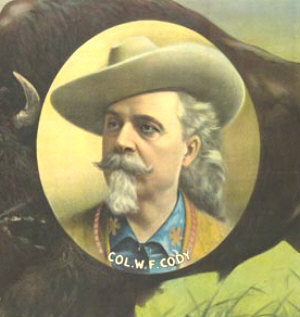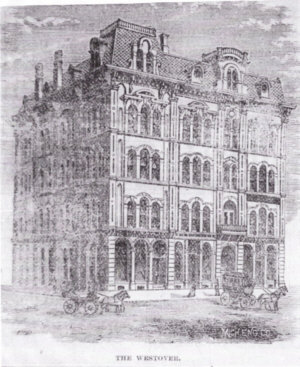What Did Lumberjacks Do When They Weren't Chopping Wood?
|
||||||||||
| Printer Friendly Story View |

Buffalo Bill Cody went to the theater in Bay City.

Westover Theater -- Famous Bay City Opera House
Why would nationally famous celebrities such as boxing champion John L. Sullivan, John Philip Sousa and his band, Edwin Booth in "Hamlet" and "Julius Caesar," and Buffalo Bill's Wild West Show with Col. William F. Cody come to little old Bay City?
In the first place, a century and more ago, Bay City wasn't little, nor was it old. Touted as the state's third city in population at one time by some writers, the frontier town grew quickly from post Civil War days because, along with East Saginaw, it was the world headquarters of the lumber industry.
Lost in the storied history of "Hell's Half Mile" and legendary drunken lumberjacks is the fact that they loved the theatre -- mainly the "legitimate" type, of course.
An incredible variety of stage productions were presented here and the number of theatres and performance halls, estimated at more than 100 at one point, rivaled the saloons existing in the 1870s and 1880s.
Thanks to two academics with local connections, we have an amazing record of those pre-movie theatre, radio and television days.
Traveling vaudeville and dramatic companies circled the nation, stopping at places like Bay City where large numbers of residents had the wherewithal to pay admittance fees.
Local productions began with the Bay City Amateur Dramatic Society's "All That Glitters is Not Gold," offered at Globe Hall Sept. 26, 1866. That kicked off a long tradition of "community theatre" here still carried on by the Bay City Players.
The lumberjack era was notable for the fact that hundreds of manual labor workers amassed substantial, for those days, sums while working isolated in the northern Michigan woods all winter.
When they arrived in the spring, mainly on trains after the 1870s, their pockets were stuffed with cash. For several months work at about $1 per day, most had at least $75 left when they hit Bay City.
The lumberjacks were seeking, as the Historical Press book "Paul Bunyan: How A Terrible Timber Feller Became A Legend," recounts, "what came in bottles and corsets." (See www.paulbunyanbook.com) See also "Michigan Lumbertowns" by Dr. Jeremy Kilar and "Ghosts, Crimes and Urban Legends of Bay City, Michigan," both available at the Bay County Historical Museum, along with the Paul Bunyan book.
The lumberjacks paid up to $5 for a visit to sin dens like the notorious European Hotel and the Catacombs where they would be attended by what the local press decorously called "pretty waiter girls."
But they also obviously craved more public entertainment and crowded into local halls any time a show struck their fancy.
They were willing to pay up to $2 for a seat during a dramatic production in the loges of Wood's Opera House, the successor to the Westover, which burned mysteriously in 1886. The Westover had been shut by owner William Westover, who declared it no longer safe for patrons.
The Westover Block at the southwest corner of Center and Washington housed a popular opera house in its two upper stories and the Fraser House hotel on Water Street had a public hall seating 800, with provisions for expansion in case of a large crowd.
James M. Wood, Chicago theatre architect, had been hired to rebuild the Westover and, after the fire, collaborated with leading local citizens to raise $40,000 and build the new opera house. Other names considered for the venue were the Bijou and the Grand.
Other entertainment venues here included just about anyplace a crowd of more than several dozen could be accommodated. Some were the Academy of Music, West Bay City; Arbeiter Hall, Washington Rink Opera House, Bordwell's Opera House, Theatre Comique, Forester's Hall, Marble Hall, Ladies' Loyal Orange Lodge Hall, the Ridotto, Norrington Opera House, West Bay City; Red Cross Hall, Sage Library, Red Ribbon Hall, Wenona Beach Pavilion, and Women's Christian Temperance Union Hall, plus dozens of churches, union halls, schools and even the City Mission.
The first production by an itinerant theatrical company was "Uncle Tom's Cabin," a spin off from Harriet Beecher Stowe's 1852 blockbuster book of that name. "Uncle Tom's Cabin" was performed here at least yearly by a variety of companies until 1900.
John H. Gore, a native of Gagetown and former English professor at Wayne State University, Detroit, and Georgia State University, Americus, Georgia, produced an amazing study of the Bay City theatre scene.
Prof. Gore documented every stage production from 1865 to 1900 in a 1,042 page dissertation for his degree of doctor of philosophy at Wayne State in 1966. More than 700 pages in the two volumes of the dissertation are devoted to lists of dramatic productions presented here.
The tome, in two volumes, lists every production at every venue, often commenting on the crowd or the quality of the production.
The fact that a doctoral student in Detroit would travel to Bay City, perhaps over many years, to complete this monumental work, is testimony to the vigor of the local theatre.
Perhaps during his research trips here, Prof. Gore would wind up in Gagetown for a visit with relatives before returning to his work in Detroit.
Since Gore was born in 1912, it is assumed that the professor, who retired in 1982 in Georgia, he has died but no confirmation of that has been found. He would be nearly 100 if he survives.
Another writer, Raymond J. Lewandowski, in his dissertation for a master's degree in Speech in 1962 at Michigan State University, focused on the transition from the Westover to the Wood's Opera House from 1884 to 1902, when the Wood's burned.
Lewandowski wrote: "The destruction of Wood's Opera House marked the end of a theatrical era in Bay City. The city no longer enjoyed the financial boom of the past, and, as the growth and prosperity of the community slowed, so did the interest and exercise of legitimate professional theatre."
The Washington Theatre at Washington Avenue and Sixth Street succeeded the Wood's as the world of stage entertainment evolved with motion pictures. The Washington seated more than 1,500. Lewandowski noted that visitors to the Washington's basement could see the charred remnants of the old Wood's opera house.
At the Washington, some ties to the glory days persisted for a while. Such stars as the Barrymores, (Ethel, John and Lionel), David Warfield and George Arliss, continued the tradition of celebrity productions here.
Stage productions and some local shows like "Youth on Parade" highlighted local dancers who had attended dancing schools. These shows persisted into the 1950s and 1960s when the schools began to stage their own sometimes elaborate shows.
Both academic treatises on the Bay City entertainment scene are available in the local reference room of the Wirt Public Library. ###
| Printer Friendly Story View |
|
|

Dave Rogers |
|
|
|
Printer-Friendly Story View
0200 Nd: 04-21-2024 d 4 cpr 0
12/31/2020 P3v3-0200-Ad.cfm
SPONSORED LINKS
12/31/2020 drop ads P3v3-0200-Ad.cfm


